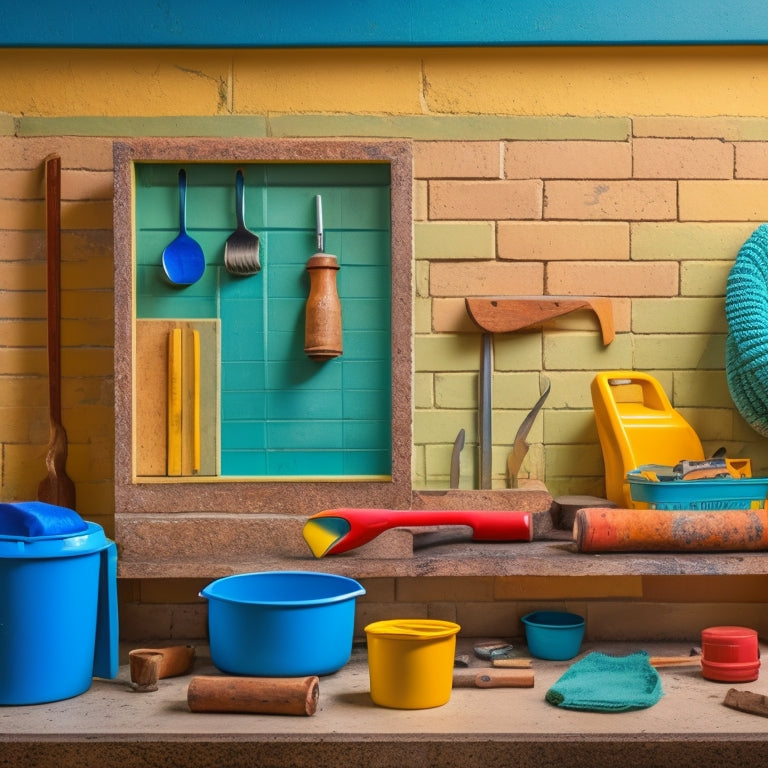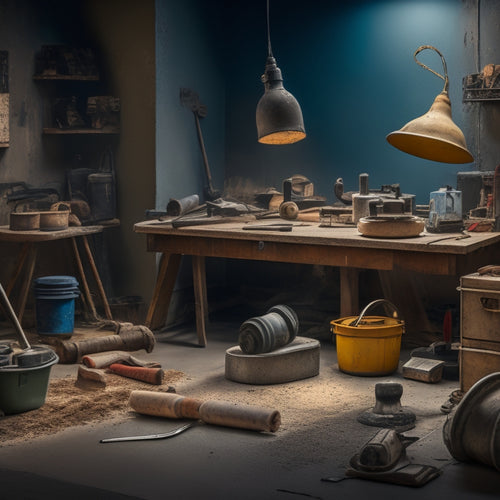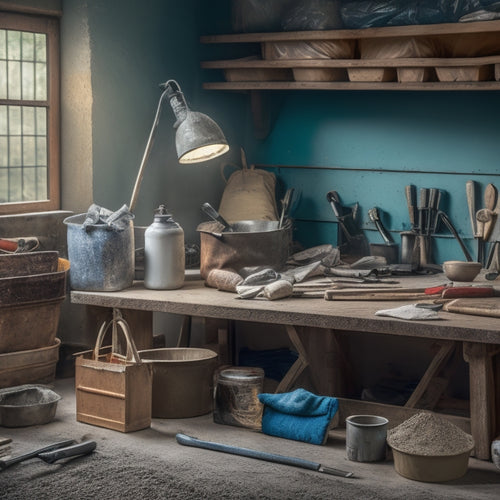
Concrete Wall Covering Tools for Beginners
Share
You'll need a range of power tools, drilling and mixing tools, and surface preparation equipment to successfully cover a concrete wall, starting with a rotary hammer or hammer drill for drilling into the concrete. Prioritize safety equipment, including safety glasses, gloves, and dust masks, then move on to essential drilling and mixing tools like carbide-tipped or diamond-coated bits and a mixing stick. Next, prepare the surface by cleaning, degreasing, and pressure washing, before applying a primer or bonding agent and your chosen concrete wall coating. From here, you can refine your technique and achieve a professional-looking finish by following specific guidelines for application and sealing.
Key Takeaways
• Choose the right power tool for the task: drilling, grinding, or sawing, and prioritize safety equipment like safety glasses and gloves.
• Invest in essential drilling and mixing tools, including a hammer drill, carbide-tipped bits, and a mixing bucket and stick.
• Properly prepare the surface by cleaning, degreasing, and pressure washing to ensure a strong bond with the covering material.
• Select the appropriate application technique for your concrete wall coating, such as roll-on, brush-on, or spray-on, and follow manufacturer's instructions.
• Finish and seal the surface with texture techniques and sealing products that provide moisture resistance and UV protection.
Choosing the Right Power Tools
When it comes to covering concrete walls, you'll need to select the right power tools for the job to guarantee efficient and effective results. The type of power tool you choose will depend on the specific task at hand, such as drilling, grinding, or sawing.
For drilling, you'll need a rotary hammer or a hammer drill, while grinding requires an angle grinder or a concrete grinder. Sawing, on the other hand, calls for a circular saw or a concrete saw.
Regardless of the power tool type, it's crucial to prioritize safety equipment. You'll need to wear protective gear, including safety glasses, gloves, and a dust mask to prevent injury from flying debris and dust.
Additionally, consider investing in a respirator to protect yourself from airborne particles. Make sure you're familiar with the power tool's operating manual and follow the manufacturer's guidelines to avoid accidents.
Essential Drilling and Mixing Tools
With your safety equipment in place and the right power tools selected, you'll need to turn your attention to the specific drilling and mixing tools required to prepare the surface of your concrete wall for covering.
When it comes to drilling, you'll need a hammer drill or rotary hammer with appropriate drill bits, such as carbide-tipped or diamond-coated bits, designed specifically for concrete. Familiarize yourself with advanced drilling techniques, like using a slow and steady motion to prevent overheating, and applying gentle to moderate pressure to avoid damaging the wall.
For mixing, you'll need a mixing bucket, a mixing stick or paddle, and a measuring cup or scale to guarantee accurate mixing ratios. The mixing ratio will depend on the type of covering material you're using, so be sure to follow the manufacturer's instructions. A general rule of thumb is to use a 1:1 or 2:1 ratio of cement to sand.
Mix the ingredients thoroughly, scraping the sides and bottom of the bucket to prevent lumps from forming. By having the right drilling and mixing tools, you'll be well-prepared to create a strong and durable bond between your concrete wall and the covering material.
Surface Preparation and Cleaning
You'll need to thoroughly clean and prepare the surface of your concrete wall to guarantee a strong bond between the wall and the covering material. This essential step requires a combination of specialized tools and careful attention to detail.
Any dirt, grime, or old adhesives left on the surface can compromise the adhesion of your covering material, leading to peeling, flaking, or even complete failure.
To confirm a strong bond, you'll need to employ effective surface cleaning techniques and wall preparation methods. Here are some essential tools and steps to include in your process:
-
A wire brush or scrubber to remove loose dirt and debris
-
A degreaser or solvent to dissolve and remove grease, oil, or wax
-
A pressure washer to blast away stubborn stains and dirt
-
A scraper or putty knife to remove old adhesives or stubborn stains
-
A vacuum cleaner or blower to remove dust and debris from the surface
Applying Concrete Wall Coatings
Now that your concrete wall surface is clean and prepared, apply a suitable primer or bonding agent to confirm a strong, lasting bond between the wall and the coating material. This essential step guarantees a smooth, even application of the coating and prevents peeling or flaking.
Coating Techniques and Application Tips
| Coating Technique | Application Tip |
|---|---|
| Roll-on | Use a high-nap roller to achieve a textured finish |
| Brush-on | Work in small sections to maintain even coverage |
| Spray-on | Hold the sprayer 10-12 inches from the wall for best coverage |
| Trowel-on | Use a putty knife to spread the coating evenly |
| Stamp-on | Apply the coating in thin layers to prevent stamp pattern distortion |
When applying the coating, follow the manufacturer's instructions for drying time, coverage rate, and recommended thickness. Pay attention to temperature and humidity conditions, as these can affect the coating's performance. Additionally, confirm you have the necessary safety gear, such as gloves and a mask, to protect yourself from potential health risks. By following these coating techniques and application tips, you'll achieve a professional-looking finish that will last for years to come.
Finishing and Sealing the Surface
How do you guarantee a durable, long-lasting finish for your concrete wall coating, while also protecting it from the elements and daily wear and tear? The answer lies in proper finishing and sealing techniques.
To achieve a professional-looking finish, you'll need to employ various texture techniques, such as troweling, stamping, or stenciling, to create the desired pattern or design.
Once you've achieved the desired texture, it's time to seal the surface.
Here are some essential steps to follow:
-
Choose the right sealing products for your specific concrete wall coating, considering factors like moisture resistance, UV protection, and color retention.
-
Confirm the surface is clean and dry before applying the sealant.
-
Apply the sealant according to the manufacturer's instructions, using the recommended tools and techniques.
-
Allow the sealant to dry completely before exposing the wall to traffic or the elements.
-
Regularly inspect and maintain the sealant to confirm its effectiveness and extend its lifespan.
Frequently Asked Questions
Can I Use Concrete Wall Covering Tools for Other DIY Projects?
You can repurpose concrete wall covering tools for alternative applications, like texturing furniture or creating unique decorative pieces, and even tackle creative projects, such as molding custom planters or sculpting outdoor art.
How Do I Store and Maintain My Concrete Wall Covering Tools?
You'll want to prioritize tool organization by categorizing and storing each item in a designated area, then follow maintenance tips like regular cleaning and lubrication to extend their lifespan and guarantee peak performance.
Are Concrete Wall Covering Tools Suitable for Outdoor Use?
When working outdoors, you'll want to make certain your tools can withstand the elements. Look for weather-resistant materials and coatings that guarantee outdoor durability, so your tools remain effective and reliable in any condition.
Can I Share or Lend My Concrete Wall Covering Tools to Friends?
When deciding to share your tools with friends, consider the benefits of tool sharing on your friendships, but first, inspect your equipment for wear, and set clear expectations to avoid misunderstandings and damage.
Do I Need to Wear Protective Gear When Using Concrete Wall Covering Tools?
When working with concrete wall covering tools, you'll need to wear protective gear, including gloves to shield your hands from abrasive materials and eye protection like goggles or safety glasses to prevent debris from causing damage.
Conclusion
You've finally reached the finish line! With the right tools and techniques under your belt, you're ready to tackle that concrete wall covering project.
Remember, 'practice makes perfect,' so don't be discouraged if it doesn't turn out exactly as planned at first. Keep at it, and you'll be a pro in no time.
Your hard work will pay off, and your concrete wall will be transformed from drab to fab.
Now, get out there and start covering!
Related Posts
-

Must-Have Tools for Laying Concrete Tiles
When laying concrete tiles, you'll need a range of essential tools to get the job done right. Start with subfloor pre...
-

Top Concrete Resurfacing Tools for a Pro Finish
When it comes to achieving a professional finish in concrete resurfacing projects, you require the right set of speci...
-

10 Must-Have Tools for Small Concrete Projects
When tackling small concrete projects, you'll need a range of essential tools to achieve professional-grade results. ...


